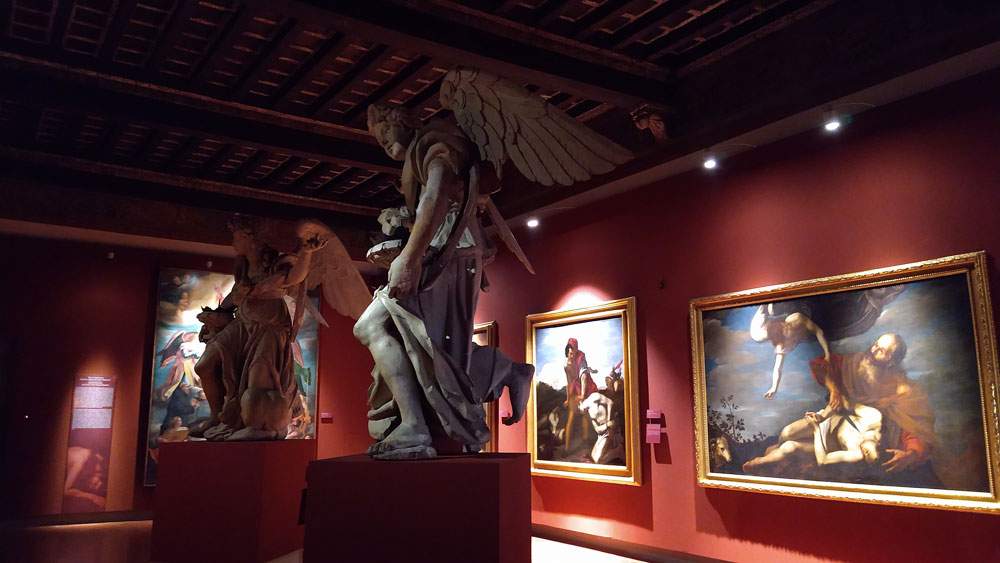Pisa celebrates one of its greatest masters: Orazio Riminaldi, between Gentileschi and Caravaggio
The exhibition Orazio Riminaldi opens on May 28, 2021 in Pisa, at the Palazzo dell’Opera in Piazza dei Miracoli. A Pisan Master between Caravaggio and Gentileschi, open to the public until September 5, 2021.
Curated by Pierluigi Carofano and Riccardo Lattuada and organized by theOpera della Primaziale Pisana, the exhibition was conceived on the occasion of the recent restoration of the paintings of the dome of the Pisan cathedral, a masterful and evocative masterpiece by Orazio Riminaldi completed between 1627 and 1630. Amonumental work, completely painted in oil, not fresco, depicting the Assumption carried to heaven by angels and a theory of saints. The restoration was necessary because the legibility of the work from below was precarious, due to the dirt that had gradually accumulated on the walls over the decades.
For thefirst time, thanks to this review, the human and artistic journey of the Pisan master Orazio Riminaldi (Pisa 1593 - 1630), a pupil of Orazio Gentileschi and fascinated in his youth by the painting of Caravaggio, is to be highlighted.
Arriving in Rome around 1615, he became an academician of San Luca and was part of the third season of the Caravaggio masters. He was able to express himself in a most elegant pictorial language that beautifully combined the style of Orazio Gentileschi and that of Guido Reni. He died of a beating when he was only thirty-seven years old, but in the course of his short life and production he produced true masterpieces, the most monumental of which is preserved in Pisa, namely the dome of the Duomo.
On display in a careful arrangement are Riminaldi’s paintings from prestigious public collections, his Self-Portrait, preparatory models for the dome, particularly the splendid study for the face of the Virgin, and the model of the Assumption of the Virgin, and the Portrait of the Primaziale Worker Curzio Ceuli, the one who is credited with Riminaldi’s realization of the Pisa masterpiece.
The exhibition is divided into nine sections, starting with a contextualization of the Pisan environment in which Orazio Riminaldi was formed, then moving on to the Roman environment (with works by Guido Reni, Giovanni Baglione, and Agostino Tassi), without neglecting his early masters, Ranieri Borghetti and Aurelio and Orazio Lomi Gentileschi. By Orazio Gentileschi, the public will be able to admire the Madonna and Child from the National Galleries of Ancient Art in Palazzo Corsini and Judith with the Head of Holofernes from the Lemme Collection in Rome. Also on display are important works by masters related to him, such as St. Cecilia with the Portable Organ by Giuseppe Cesari known as Cavalier d’Arpino, Guido Reni’s St. Peter the Penitent and Guercino’s St. Cecilia from the Sorgente Group Foundation.
Other rarities featured in the first rooms of the exhibition are St. Andrew and St. Bartholomew, from the Accademia di San Luca in Rome: fragments of a large altarpiece by Bronzino originally placed in Pisa Cathedral but dispersed in antiquity.
Starting from his training in typical Tuscan taste to his encounter with Caravaggio’s naturalism, later declining toward a more mature classicism, the exhibition then traces Orazio Riminaldi’s production through more than 20 works. These include the Sacrifice of Isaac and the Martyrdom of Saints Nereus and Achilleus (from the National Galleries of Ancient Art at Palazzo Barberini and Palazzo Corsini in Rome), Cain and Abel (from the Uffizi Galleries), the Dressing of Saint Bona (from the church of San Martino in Pisa), and Hercules and Acheloo from the Giovanni Sarti Gallery in Paris.
At the conclusion of the exhibition tour, it will be possible to enter the cathedral to admire the dome painted by Riminaldi, as well as two of his canvases in the Tribune: the Samson and Moses and the Bronze Serpent.
The exhibition is accompanied by a catalog, published by EDIFIR, which aims to illustrate the sections of the exhibition through historical-critical essays for each part. In addition, there will be scientific fact sheets for each work on display, containing essential philological and critical information, and a final bibliography.
For information and reservations: www.opapisa.it
Pictured is a room of the exhibition.
 |
| Pisa celebrates one of its greatest masters: Orazio Riminaldi, between Gentileschi and Caravaggio |
Warning: the translation into English of the original Italian article was created using automatic tools. We undertake to review all articles, but we do not guarantee the total absence of inaccuracies in the translation due to the program. You can find the original by clicking on the ITA button. If you find any mistake,please contact us.





























